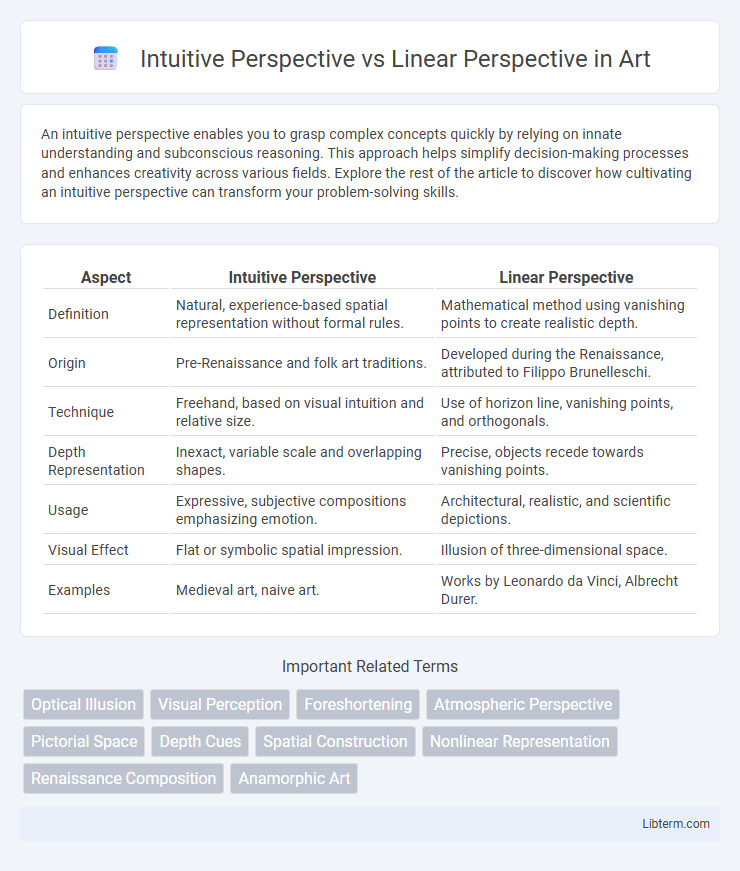An intuitive perspective enables you to grasp complex concepts quickly by relying on innate understanding and subconscious reasoning. This approach helps simplify decision-making processes and enhances creativity across various fields. Explore the rest of the article to discover how cultivating an intuitive perspective can transform your problem-solving skills.
Table of Comparison
| Aspect | Intuitive Perspective | Linear Perspective |
|---|---|---|
| Definition | Natural, experience-based spatial representation without formal rules. | Mathematical method using vanishing points to create realistic depth. |
| Origin | Pre-Renaissance and folk art traditions. | Developed during the Renaissance, attributed to Filippo Brunelleschi. |
| Technique | Freehand, based on visual intuition and relative size. | Use of horizon line, vanishing points, and orthogonals. |
| Depth Representation | Inexact, variable scale and overlapping shapes. | Precise, objects recede towards vanishing points. |
| Usage | Expressive, subjective compositions emphasizing emotion. | Architectural, realistic, and scientific depictions. |
| Visual Effect | Flat or symbolic spatial impression. | Illusion of three-dimensional space. |
| Examples | Medieval art, naive art. | Works by Leonardo da Vinci, Albrecht Durer. |
Introduction to Artistic Perspectives
Intuitive perspective relies on an artist's eye to create depth without strict rules, often resulting in a more expressive and dynamic composition. Linear perspective uses mathematical principles and vanishing points to depict space and depth accurately, producing realistic and proportionate scenes. Understanding both perspectives is crucial for artists to effectively convey spatial relationships and enhance visual storytelling.
Defining Intuitive Perspective
Intuitive perspective is a drawing method that represents space based on visual intuition rather than strict mathematical rules, allowing artists to depict depth by observing objects as they appear naturally. Unlike linear perspective, which relies on fixed vanishing points and geometric constructions, intuitive perspective captures spatial relationships through subjective perception and proportional scaling. This approach empowers artists to convey depth in scenes where traditional perspective methods may be challenging or less effective.
Understanding Linear Perspective
Linear perspective is a mathematical technique used in art and design to create the illusion of depth and space on a flat surface by converging parallel lines toward one or more vanishing points on the horizon line. It relies on precise geometric principles, including horizon lines and orthogonal lines, to produce realistic spatial relationships and proportional scaling of objects as they recede into the distance. Mastery of linear perspective enables artists and architects to depict three-dimensional environments accurately, enhancing visual coherence and spatial understanding in their compositions.
Historical Evolution of Perspective Techniques
Intuitive perspective emerged during the early Renaissance as artists sought to represent spatial depth based on visual observation and instinctive understanding rather than mathematical accuracy. Linear perspective, formalized by Filippo Brunelleschi in the 15th century, introduced a systematic, geometric approach using vanishing points and horizon lines to create accurate depth and proportion in artworks. The transition from intuitive to linear perspective marked a pivotal advancement in Western art, enabling more realistic and scientifically grounded representations of three-dimensional space on two-dimensional surfaces.
Key Differences: Intuitive vs Linear Perspective
Intuitive perspective relies on an artist's perceptual judgment to create depth and spatial relationships, often resulting in less precise, more subjective representations. Linear perspective uses mathematical principles and vanishing points to construct accurate, proportionate depictions of space, ensuring consistent scale and depth. Key differences lie in intuition-driven versus rule-based methods, where intuitive perspective offers artistic flexibility and linear perspective provides geometric accuracy.
Artistic Applications of Intuitive Perspective
Intuitive perspective in artistic applications prioritizes visual experience and emotional impact over mathematical accuracy, allowing artists to create more expressive and dynamic compositions. This approach often distorts scale and depth to emphasize focal points and narrative elements, enhancing the viewer's engagement. Artists leverage intuitive perspective to break free from rigid spatial rules, fostering creativity and personal interpretation in their work.
The Science and Mathematics of Linear Perspective
Linear perspective relies on precise mathematical principles, using a vanishing point and horizon line to create the illusion of depth on a flat surface. This scientific approach involves geometry and spatial algorithms that replicate how light rays converge in the human eye, enabling accurate scale and proportion in artworks. Unlike intuitive perspective, which depends on visual estimation, linear perspective is governed by formulas that ensure consistent dimensionality and realism.
Emotional Impact on Viewer Perception
Intuitive perspective uses natural spatial cues and organic composition to evoke emotional responses, fostering a sense of familiarity and immediacy in the viewer's perception. Linear perspective, with its structured vanishing points and precise geometry, creates a sense of depth and order, often eliciting feelings of stability and control. The emotional impact varies as intuitive perspective engages personal interpretation, while linear perspective guides the viewer's focus through calculated spatial relationships.
Notable Artists and Iconic Works
Notable artists like Giotto di Bondone pioneered the use of intuitive perspective in the early 14th century, exemplified by his frescoes in the Scrovegni Chapel that create a sense of depth through overlapping and size variation. Linear perspective was revolutionized by Filippo Brunelleschi in the 15th century and later perfected by artists such as Leonardo da Vinci, whose "The Last Supper" masterfully employs vanishing points to achieve realistic spatial depth. The shift from intuitive to linear perspective marked a significant transformation in Renaissance art, enabling iconic works to depict three-dimensional space with mathematical precision.
Choosing the Right Perspective for Your Art
Choosing the right perspective for your art hinges on the desired emotional impact and visual narrative. Intuitive perspective prioritizes artists' perception and expressive freedom, often resulting in dynamic compositions that reflect subjective reality. Linear perspective relies on geometric principles and vanishing points to create accurate spatial depth, ideal for realistic and architectural artworks demanding precise proportion and scale.
Intuitive Perspective Infographic

 libterm.com
libterm.com